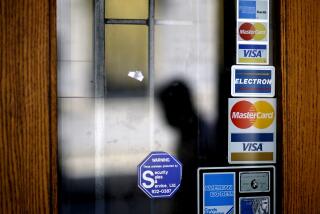Consumers Slow Pace of Borrowing
- Share via
WASHINGTON — U.S. consumers took on new debt in March at the slowest pace in a year and a half, a sign they might be growing more cautious in their spending habits as the economy slackens.
The Federal Reserve said Monday the amount of consumer installment debt outstanding--which includes car loans, student loans and credit card debt--grew by $6.16 billion in March, the smallest rise since a $5.33-billion rise in October 1999.
That followed a gain of $13.36 billion in February, which was revised down slightly from the previously reported $13.5-billion increase.
“It’s consistent with some of the numbers we’ve had showing a drop-off in motor vehicle sales,” said Dan Laufenberg, chief economist at American Express Financial Advisors in Minneapolis. “I would guess a good part of the slowdown is car loans.”
Consumer credit grew at an annual rate in March of 4.7%, a sharp deceleration from the rate of 10.4% recorded in February.
The total gain in credit was less than the $9.4 billion economists forecast in a Reuters survey.
Consumer installment debt--which is any kind of debt except for home mortgages that requires regular monthly payments--has been rising robustly.
For example, in four of the last eight months the annual percentage increases in consumer credit have been in the double digits.
In March, the entire gain in credit outstanding was in revolving debt, or credit card debt. Such debt was up $6.61 billion, or at an annual rate of 11.7%, after a $10.97-billion in rise in February.
Nonrevolving loans, such as those for cars or education, fell by $455 billion in March after a $2.39-billion increase in February. They were down at an annual rate in March of 0.6%.
Credit cards typically are the most costly source of debt, so a shift to them by consumers could indicate that they have tapped out other sources of credit.
However, some economists noted that March was a big month for home refinancings, so consumers might have pulled some equity out of their homes and used the money to pay off other debt.
More to Read
Inside the business of entertainment
The Wide Shot brings you news, analysis and insights on everything from streaming wars to production — and what it all means for the future.
You may occasionally receive promotional content from the Los Angeles Times.










